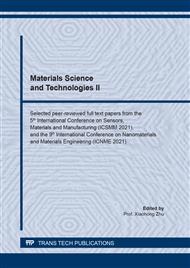[1]
M. Ahmed, S. Islam, S. Nazar and R. Khan: Arab. J. Sci. Eng. Vol. 41 (2016) p.1403–1412.
Google Scholar
[2]
Neville A Properties of concrete (Pearson, New York 2011).
Google Scholar
[3]
J. Tao, L. Tingwei and L. Xujian: Cem. Concr. Res. Vol. 36 (2006) pp.1399-1408.
Google Scholar
[4]
S. Wani, T. Muntazari and N. Rafique: Chall. J. Concr. Res. Lett. Vol. 12 (2021) pp.20-29.
Google Scholar
[5]
M. León and F. Ramírez: Rev. Ing. de Construcción Vol. 25 (2010) pp.215-240.
Google Scholar
[6]
ACI 211.1 Standard for Selecting Proportions for Normal, Heavyweight, & Mass Concrete.
Google Scholar
[7]
M. Nataraja and D. Lelin: Indian Concr. J. Vol. 84 (2010) pp.64-70.
Google Scholar
[8]
H. Qasrawi: Adv. Civ. Eng. Vol. 2016 (2016) 1035946.
Google Scholar
[9]
I. Ejiogu, P. Mamza, P. Nkeonye and A. Yaro: Pac. J. Sci. Technol. Vol. 19 (2018) pp.22-36.
Google Scholar
[10]
R. Solis, E. Moreno and E. Arjona: Rev. Fac. Ing UCV Vol. 27 (2012) pp.43-50.
Google Scholar
[11]
G. Taylor Materials in Construction: An Introduction (Routledge, London 2000).
Google Scholar
[12]
T. Nwofor, S. Sule and D. Eme: Int. J. Sci. Eng. Res. Vol. 6 (2015).
Google Scholar
[13]
M. Gambhir Concrete Technology (Tata McGraw Hill Education, New Delhi 2011).
Google Scholar
[14]
IS:10262-2019 Indian Standard Concrete Mix Proportioning-Guidelines (Second Revision).
Google Scholar
[15]
D. Abrams Design of concrete mixtures (Lewis Institute, Chicago 1919).
Google Scholar
[16]
D. Ukala : J. Appl. Sci. Environ. Manag. Vol. 23 (2019).
Google Scholar
[17]
S. Popovics Mag. Concr. Res. Vol.18 (1966) pp.131-140.
Google Scholar
[18]
E. Rivva y E. Pasquel Tecnología del concreto (ACI-Capítulo Peruano, Lima 1999).
Google Scholar
[19]
S. Walker and D. Bloem: ACI J. Proc. Vol. 57 (1966).
Google Scholar
[20]
R. Santhosh and P. Shivananda: Int. J. Res. Appl. Sci. Eng. Technol. Vol. 5 (2017).
Google Scholar
[21]
K. Lohote, R. Dumbre, S. Sagale and A. Unde: Int. J. Eng. Sci. Manag. Res. Vol. 7 (2017).
Google Scholar
[22]
A. Chhachhia: J. Bui.Mat.Sci. Vol. 2 (2020) pp.30-33.
Google Scholar
[23]
H. Kim, I. Kim, W. Yang, S. Moon and J. Lee: Sustainability Vol.13 (2021).
Google Scholar
[24]
J. Park, S. Tae and T. Kim: Renew. Sust. Energ. Rev. Vol.16 (2012) p.2940–2946.
Google Scholar
[25]
J. Opon and M. Henry: J. Clean. Prod. Vol.218 (2019) pp.718-737.
Google Scholar
[26]
H. Campos, N. Klein and J. Marques Filho: J. Clean. Prod. Vol.265 (2020).
Google Scholar
[27]
Revansiddappa et al: Int. J. Eng. Adv. Technol. Vol.7 (2020) pp.682-685.
Google Scholar
[28]
Naciones Unidas La agenda 2030 y los objetivos de desarrollo sostenible (2018).
Google Scholar
[29]
World Business Council for Sustainable Development Vision 2050: Time to transform (2021).
Google Scholar
[30]
ASTM C33 / C33M-18 Standard Specification for Concrete Aggregates.
Google Scholar
[31]
UNACEM Ficha Técnica: Cemento Sol (Unacem, Lima 2021).
Google Scholar
[32]
Chema Hoja de Datos del Producto: Chema Plast (Chema Peru, Lima 2018).
Google Scholar
[33]
ASTM C1602M-18 Specification for Mixing Water Used in Hydraulic Cement Concrete.
Google Scholar
[34]
ASTM C136M-19 Standard Test Method for Sieve Analysis of Fine and Coarse Aggregates.
Google Scholar
[35]
ASTM C29M-17a Standard Test Method for Bulk Density and Voids in Aggregate.
Google Scholar
[36]
ASTM C127-15 Standard Test Method for Relative Density & Absorption of Coarse Aggregate.
Google Scholar
[37]
ASTM C128-15 Standard Test Method for Relative Density & Absorption of Fine Aggregate.
Google Scholar
[38]
C. Cuadrado Constructivo Suplemento Técnico Edición 151(Lima: Constructivo, Lima 2021).
Google Scholar
[39]
M. Ahmed, J. Mallick, S. AlQadhi and N. Kahla: Sustainability Vol.12 (2020).
Google Scholar


